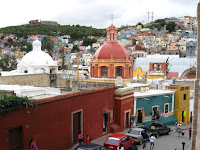
 On Sunday evening I saw an incredible display of soccer fanaticism, both amazing and ugly.
On Sunday evening I saw an incredible display of soccer fanaticism, both amazing and ugly.The Fulbright Comission bought tickets for 20 Fulbrighters to attend the Clasico de Clasico: Chivas (from Guadalajara-2nd largest city) vs. América (from Mexico City-largest city). The stadium can hold up to 106,000 people and it appeared as though every seat was taken! We were sitting next to a fenced section of the stadium which was surrounded by police with riot gear on. This section was for the "fanatics" of the team América. The section for Chivas was opposite up on the 3rd level, they too were surrounded by police in riot gear. Other fans for both teams were mixed up in the crowd; best friends, couples, families all wearing different jerseys from both teams. Good natured teasing and taunting occurred during the entire match. The 'fanatic' sections had drums that went on during the game, they would break out in the song of their team (sometimes spurred on by the announcer) and the entire crowd would join in, it was deafening and sent chills down my spine. I had always heard it during games on television but had no idea how cool it really is!
Chivas ended up winning 2-1.
We stood around until the stadium was almost empty because the Fulbright leaders didn't want to lose anyone in the crowd. We noticed that the 'fanatics' from the losing team, América, were kept in the gated area long after we were walking out. Apparently this is to keep them from causing any trouble.
Well, Reed and I had to take the train to the bus station and were on the platform waiting for the next train. I noticed that 4 people wearing Chivas shirts were sitting on the benches waiting for the train as well. A group of América fans (about 50) came down the stairs and were waiting to pay their fare. The police (about 10) in riot gear were on the platform and were keeping them on the steps because I think they knew the Chivas fans were there. Finally they let the América fans through. Walking by one of the girls, an América fan spit ice on one of the girls' head and some words ensued. The police ushered the Chivas fans away (towards us) from the América fans. One large policeman put himself between the groups and was talking to the Chivas fans. An América woman (who looked drunk) walked up to the group of Chivas fans and started yelling at one of the women. The policeman put up his arm to keep her away, shifted his body a little and went on talking to the man in the group. All of a sudden the drunk woman reached over the policeman's arm and punched the other woman in the face. Unfortunately, the policeman didn't see this happen. The other América fans pulled the drunk woman away. Reed and I were fortunate to squish ourselves on the next train. As the train was pulling away, we saw the policeman escorting the Chivas fans to the exit of the platform.
I guess it doesn't matter that your losing team missed three close goals (one from 2 yards in front of the goal), what matters most is that someone is wearing a shirt from the team that won! :o)
Coming next: Día de los Muertos (Day of the Dead)






